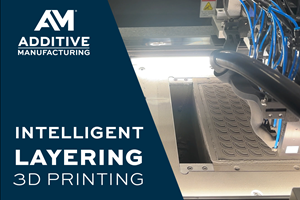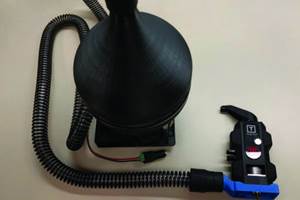Where Do I Start with Additive Manufacturing?
Here are a few basic questions to ask yourself before diving in.
Are you excited about additive manufacturing yet? Hopefully, my first few columns have given you both a preview of what is possible and a reality check on what can happen if you jump into AM blindly. This month’s column provides some tips and pointers for those just starting to explore the technology.
Many shops believe that delving into AM means they need to worry about selecting parts, investing in expensive machines and finding material suppliers, but that is putting the cart before the horse, so to speak. Over the past five years, I have found that there are four basic questions that need to be considered first, before implementing AM, and the manufacturer new to 3D printing might stumble over any of these. They are:
1. Do you design in 3D? If not, then you are not ready for AM. While larger companies have long invested in CAD and 3D solid modeling software, many smaller manufacturers and machining service providers have not and are still working with 2D drawings. This was surprising to me, too, when I first learned it, but it is a hard truth that continues to worry me the more I encounter it at smaller regional events focused on AM. So, while online repositories of CAD models are becoming more widely available (Thingiverse, GradCAD and so on), you still need to move into the 3D world and start designing digitally if you want to be able to use AM in your shop. Meanwhile, I ask those of you who consider yourselves experts in CAD: Have you started exploring lattice structures, topology optimization and generative design tools? If not, then you, too, have some work to do before you are ready to take full advantage of AM.
2. Can you 3D-print in your desired material? Currently, the palette of materials suitable for AM is rather limited, especially among metals. While many proponents talk up the material freedoms afforded by AM, the reality is that there are only a few dozen polymers and just over a dozen metals that are regularly being used. We have had years to perfect the alloys and exotic materials used in various conventional manufacturing processes (such as forging, casting and so on), but materials developed for AM are still in their infancy. Most of the materials that we are currently using were not designed to be heated and extruded from a nozzle, or melted with a laser, yet that is what we do with them in additive manufacturing.
Senvol offers a free database of industrial AM machines and materials that allows you to keep tabs on what currently is available. Beware that certain materials will not perform in AM processes as they do in other processes, however. If you pick ABS, for example, you might expect to get the properties of that material as they appear in an injection-molded part, but you will not get those properties when you 3D-print a part using ABS filament.
3. Is it possible to print your part sizes on a machine? While new AM machines are being introduced to the market fairly regularly, build envelopes still come in just a few standard sizes. Powder bed fusion systems for metals typically measure roughly 10 by 10 by 10 inches, with some exceptions. This means that if the metal part you want to additively manufacture is bigger than a machine’s build volume, you most likely are out of luck, at least in terms of printing the part directly. Larger metal-printing machines are increasingly becoming available, and the Big Area Additive Manufacturing polymer system from Cincinnati Inc., for example, is large enough to print a car body. Still, most polymer systems have a modest-sized build chamber. Again, check out Senvol’s database of machines to see what’s out there, or use resources like the Rapid Prototyping Process Selector to even better pinpoint available machines.
4. What design guidelines should you follow? If you design in 3D, you can 3D-print in the type of material you want and you can fit your parts in an AM system, then you need to start thinking about how to design for AM. While many design guidelines, rules of thumb, best practices and so on are still in development, websites like 3dhubs.com offer a nice collection online. This is tricky, however, because each additive machine behaves a little differently, and so does each type of material on each machine. So, while you may be able to print a razor-thin wall or a steep overhang in one material on one machine, you may not be able to replicate that same feature on a different machine. Also, material feedstock, especially metal feedstock, has a big influence on the success (or failure) of the build, not to mention the microstructure and mechanical properties of the resulting part. Luckily, this is where most AM research is focused right now: understanding the science of the technology enough so that we can reliably and repeatedly generate the same results, over and over and over again. Until then, AM adoption will continue to lag expectations. We—academics and companies alike—need to do a better job of sharing our results, findings and insights so that we all benefit and AM achieves its full potential.
This article originally appeared in Additive Insights, a monthly column in our sister magazine, Modern Machine Shop.
Related Content
8 Cool Parts From Formnext 2023: The Cool Parts Show #65
New additive manufacturing technologies on display at Formnext were in many cases producing notable end-use components. Here are some of the coolest parts we found at this year’s show.
Read MoreVideo: Intelligent Layering Metal 3D Printing at 3DEO
Contract manufacturer 3DEO delivers metal parts using Intelligent Layering, a binder jetting-like 3D printing process the company developed and operates internally. Here’s how it works.
Read MoreA Framework for Qualifying Additively Manufactured Parts
A framework developed by The Barnes Global Advisors illustrates considerations and steps for qualifying additively manufactured parts, using an example familiar to those in AM: the 3D printed bottle opener.
Read MoreNIOSH Publishes 3D Printing Safety Guide for Nonindustrial Settings
NIOSH has published a 3D printing safety guide for small businesses and other additive manufacturing users such as makerspace users, schools, libraries and small businesses.
Read MoreRead Next
Postprocessing Steps and Costs for Metal 3D Printing
When your metal part is done 3D printing, you just pull it out of the machine and start using it, right? Not exactly.
Read MoreAlquist 3D Looks Toward a Carbon-Sequestering Future with 3D Printed Infrastructure
The Colorado startup aims to reduce the carbon footprint of new buildings, homes and city infrastructure with robotic 3D printing and a specialized geopolymer material.
Read MoreProfilometry-Based Indentation Plastometry (PIP) as an Alternative to Standard Tensile Testing
UK-based Plastometrex offers a benchtop testing device utilizing PIP to quickly and easily analyze the yield strength, tensile strength and uniform elongation of samples and even printed parts. The solution is particularly useful for additive manufacturing.
Read More




















